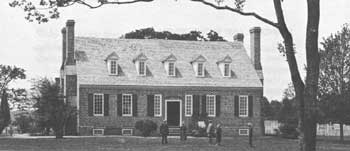





Survey of Historic Sites and Buildings
 |
GEORGE WASHINGTON BIRTHPLACE NATIONAL MONUMENT Virginia |
 George Washington Birthplace National Monument |
| ||
The memorial mansion at this site symbolizes "Wakefield," where George Washington was born, on February 22, 1732, and spent the first 3 years of his life. His family then moved farther up the Potomac, to the Hunting Creek plantation that later became known as Mount Vernon. Four years later the family moved again, to the "Strother estate," on the Rappahannock River opposite Fredericksburg.
In 1718 Augustine Washington, George's father, bought 150 acres fronting on Popes Creek, 1 mile southeast of his Bridges Creek home. On this tract he built Wakefield, probably between 1723 and 1726. It was about 6 years old at the time of George Washington's birth. George never owned it. Upon the death of his father, it passed to George's half-brother, Augustine, Jr., who lived there until he died, in 1762. The farm eventually passed to his son, William Augustine, who was living in the home during the War for Independence, when fire accidentally destroyed it. It was never rebuilt.
 |
| Wakefield, a replica of a typical Virginia plantation home of the 18th century, has been constructed to represent the boyhood home of George Washington. |
In 1882 Washington heirs and the Commonwealth of Virginia donated to the United States the old Washington family burial ground and a small plot of land at the house site. A year later the U.S. Government bought an additional 11 acres and in 1896 erected a granite shaft where members of the family had placed a stone marker in 1815. In 1923 the Wakefield National Memorial Association organized to recover the birthplace grounds and restore them as a national shrine. Several years later Congress authorized the erection of a house at Wakefield as nearly as possible like the one built by Augustine Washington. By 1931 the association, aided by John D. Rockefeller, Jr., was able to transfer to the Government enough land to bring the holding to 394 acres.
Because extensive research on the birthplace house and grounds failed to yield reliable information about the appearance of the original house, the reconstructed memorial mansion is only a general representation of a Virginia plantation house of the 18th century. Its design is based on tradition and surviving houses of the period. Archeological excavations by the National Park Service and others, however, have revealed foundation remnants that might well have been those of the original house.
 |
| George Washington Birthplace National Monument. |
Reconstruction took place in 1931-32, at which time workers moved the granite shaft to the present location. The Federal Government paid part of the cost of building the house and landscaping the grounds. The house has eight rooms, four downstairs and four in the half story up stairs. A central hallway is located on each floor. The bricks were hand made from the clay from an adjoining field. A tilt-top table in the dining room is the only surviving piece of furniture reported to have been in the original house. The furnishings are designed to portray life in the early 18th century.
Plantings near the land-front door of the house may be derived from those that grew on the place when Washington lived there as a boy. The boxwood, well over 100 years old, was brought from the home of Sarah Tayloe Washington, a daughter of the last owner of the birthplace home, and probably is descended from boxwood originally at Wakefield. In the garden near the house are found only those flowers, vines, herbs, and berries common to Virginia gardens of the period. About 50 feet from the house is a typical colonial-period frame kitchen, built on the traditional site of the old kitchen. It is furnished to represent a plantation kitchen of the period of Washington's youth, and displays artifacts recovered on the plantation.
 |
| Burial plot. |
About 1 mile northwest of the memorial mansion, on the banks of Bridges Creek, are the family burial plot and the site of the home that John Washington, George's great-grandfather, purchased in 1664. The burial plot includes the graves of George Washington's father, grand father, and great-grandfather. Washington himself was buried at Mount Vernon.
George Washington Birthplace National Monument was established in 1930. It consists of more than 390 acres, all in Federal ownership.
 |
 |
http://www.cr.nps.gov/history/online_books/founders-frontiersmen/sitea31.htm
Last Updated: 29-Aug-2005